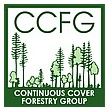CCFG National Conference 2014 – Research Poster Display
Overview
The conference included a display of 8 research projects. 4 had been submitted by students and were the winning entries in a student poster award which was funded by a donation from the School of GeoSciences, University of Edinburgh, and 4 described research being undertaken in the wider forestry community. Each presentation consisted of an A1 poster and an abstract of no more than 250 words summarizing the project.
| 1. | Andrew Glendinning (student award) |
Comparison of natural regeneration of Sitka spruce managed under different silviculture systems |
View |
| 2. | Samuel Bristow (student award) |
Effect of light levels on regeneration within an upland ash woodland (NVC W9) |
View |
| 3. | Gráinne Devlin (student award) |
Assessing the usefulness of profile diagrams as a forest and woodland management tool |
View |
| 4. | Richard Deffee (student award) |
Irregular forest management using the AFI abbreviated inventory method at the Cranborne Estate |
View |
| 5. | Christine Reid | Potential ecological impacts of ash dieback |
View |
| 6. | Andrew D. Cameron | Determining the sustainable irregular condition: a study on a transformed irregular mixed species stand at Faskally Forest, Perthshire, Scotland |
View |
| 7. | Phil Morgan and Andy Poore |
The AFI Network – GB & Ireland: monitoring irregular continuous cover forests |
View |
| 8. | Sophie Hale, Catia Arcangeli, Tom Jenkins, Mario Klopf, Christopher Thurnher and Hubert Hasenauer |
MosesGB: a growth simulator for mixed age and mixed species forest stands in Britain | View |
| 9. | Thomaz Andrade, Ryan Bowen, Rick Shakesbury, David Jenkins | Effects of successive thinning and patch clear felling to water quality at the Upper Llwi reservoir, Wales | View |
Student Poster Award

A student poster competition was run in parallel to the Conference, and was funded by a generous donation from the School of GeoSciences, Institute of Atmospheric and Environmental Science, University of Edinburgh.
The competition was open to undergraduate and postgraduate students, they could be full-time, part-time or distance learning, and on forestry, conservation or natural resources courses at any UK university or higher education college.
Entrants were to submit an abstract and then prepare a poster (A1 landscape size) on any aspect of CCF. The poster could describe research into CCF that the student had undertaken as part of their studies, or provide more general/technical information on any aspect of CCF. The abstract was to be no longer than 250 words and was assessed in terms of: relevance to CCF in Britain; clarity of goals and objectives; technical content and scope.
The assessors were Andrew Leslie (University of Cumbria), Dr. James Walmsley (Bangor University) and Russell Horsey (Institute of Chartered Foresters).
Each winner was given a conference delegate fee (valued at £145) and a travel bursary (£100) to enable them to attend the conference.
Displays and Abstracts
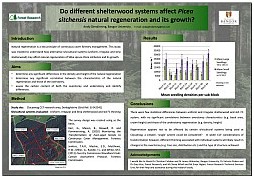
1. Comparison of Natural Regeneration of Sitka Spruce Managed under Different Silviculture Systems
Andrew D. Glendinning
Postgraduate, Distance Learning Student, Forestry, School of Environment, Natural Resources and Geography, Bangor University
Abstract:
Natural regeneration is considered one of the principles of continuous cover forestry management and its associated silvicultural systems. To aid UK forestry gain a better understanding of these alternative systems and how they might affect natural regeneration, the Clocaenog Continuous Cover Forestry Research Area, North Wales, was established in 2002. Chosen for its abundant Sitka spruce (Picea sitchensis) natural regeneration, the area was sub-divided into blocks where different silvicultural systems were implemented with interventions having occurred approximately every three years. This study set out to survey five of the Clocaenog research blocks (four under differing systems and one being a control block, where no interventions had occurred since 1999) using a systematic sampling approach. The survey design was created by the author and members of Forest Research using, as the basis, the Forestry Commission’s Monitoring the Transformation of Even-aged Stands to Continuous Cover Management and Carbon Assessment Protocol documents. The first aim of the study is to determine the significance of any differences in the density and height of the Picea sitchensis natural regeneration among the different silvicultural systems being implemented. The second aim is to determine the significance of any relationship between the characteristics of the natural regeneration and characteristics of the overstorey. The final aim of the study is to assess the carbon content of both the overstorey and understorey and identify differences in carbon content among silvicultural systems.
- View / downdload poster [PDF, 1.0 MB]
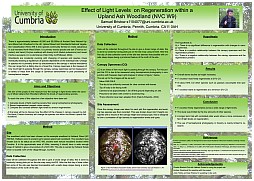
2. Effect of Light Levels on Regeneration within Upland Ash Woodland (NVC W9)
Samuel Bristow
Undergraduate Student, Forest and Woodland Management,
National School of Forestry, University of Cumbria
Abstract:
F. excelsior is an iconic tree which has occupied the landscape of the British Isles since the last ice age but how does the transmittance of light through the canopy effect how this species regenerates? Predominantly F. excelsior woodlands cover over 120,000ha within Great Britain; this study shows how F. excelsior regenerates under different levels of light measured through the concept of canopy openness using hemispherical photography to generate canopy openness scores. The study also investigates the current crisis with the pathogen C. fraxinea, how it is going to affect F. excelsior and also what species is most likely to fill the niche which could open depending on the impact of C. fraxinea. The results of this study show that F. excelsior best regenerates under a canopy openness of 21.6%, this shows how F. excelsior is a relevantly shade tolerant species.
- View / downdload poster [PDF, 4.2 MB]
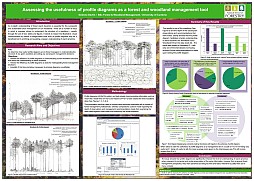
3. Assessing the Usefulness of Profile Diagrams as a Forest Management Tool
Grainne Devlin
Undergraduate Student, Forest and Woodland Management,
National School of Forestry, University of Cumbria
Abstract:
An in-depth understanding of forest stand dynamics is essential for the successful and sustainable future management of our woodlands. There are a number of ways in which a manager strives to understand the structure of a woodland –usually through the use of text, tables and figures and it stands to reason that illustrative, visual communication by means of profile diagrams may be a very beneficial tool in enriching and assisting such understanding.
The study aims to determine how useful profile diagrams are to forest managers in aiding understanding of the structure of a woodland and consequent management decisions. This study aims to assess the efficiency of profile diagrams in communicating current woodland structure, their usefulness as tools for aiding management decisions, and also to establish whether or not the work necessary to produce diagrams is justifiable in relation to their usefulness.
Profile diagrams (60x10m), and data sheets (communicating information such as mean Dbh, Basal Area (m2; ha-1) and Volume (m3; ha-1)) were created for three woodlands. This information was then used to conduct semi-structured interviews with a number of forest management professionals, whereby comparisons could be made regarding the observations and management recommendations made from examining the data sheets against those made from examining the profile diagrams.
The study showed that profile diagrams do significantly enhance the level of understanding of stand dynamics when compared to numerical and verbal presentation of the same information, however from a general forest management perspective, they were perceived as being too time and labour intensive to justify their use in many contexts.
- View / downdload poster [PDF, 2.6 MB]
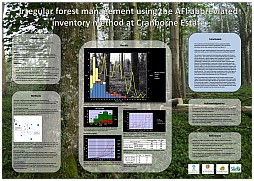
4. Irregular Forest Management Using the AFI Abbreviated Inventory Method at the Cranborne Estate
Richard Deffee
Postgraduate, Distance Learning Student, Forestry,
Department of Natural Sciences and Geography, Bangor University
Abstract:
The transformation of even-aged stands to complex heterogeneous forest structures is a major challenge. Continual monitoring of changes in both space and time can aid in decision-making during interventions in the growing stock, inform development of optimal economic conditions, and assess achievements in meeting transformation targets. Sampling using fixed-area plots (Hamilton, 1975) has until now been the dominant monitoring strategy in UK forests. This study suggests that the inventory method developed by the Association Futaie Irrégulière (AFI), utilising plots based on the relascope principle, may be more efficient than fixed-area methods when monitoring irregular stand conditions.
The study site was a complex irregular broadleaf stand situated on the Cranborne Estate (Dorset). Fixed area and relascope-based plots were created and surveyed. Complete enumeration of the stand was also carried out to establish baseline data for comparing the accuracy of these methods for the three stand variables; stem density, basal area, and diameter class distribution.
The results showed that the AFI method produced detailed dendrometric data which could be applied to single tree models to determine economic optimisation and facilitate development of a sustainable irregular structure.
Fixed-area plots exhibited considerably larger uncertainty estimates for structure (especially for larger diameter trees), and larger between plot variance in basal area, than did AFI plots of a comparable scale. Moreover, it was shown that for a given labour input, the fixed-area method delivered an inadequate sample of large trees for a reliable estimate for increment under the continual inventory principle.
- View / downdload poster [PDF, 3.0 MB]
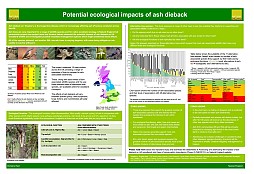
5. Potential Ecological Impacts of Ash Dieback
Christine Reid
Natural England
Peterborough
Abstract:
Ash dieback (or ‘Chalara‘), is the fungal tree disease which is increasingly affecting ash (Fraxinus excelsior) across the UK. Ash trees are very important for a range of wildlife species and for native woodland ecology. How should we manage woodlands infected by ash dieback in ways that conserve their associated wildlife?
This project assesses the potential ecological impact of ash dieback on UK woodlands wildlife and investigates possible woodland management options which might ameliorate the problems caused.
In particular it:
- Identifies the ecological function of ash (decomposition, litter quality, nutrient cycling) and of 11 alternative tree species that might replace ash, for comparison.
- Identifies which wildlife species are associated with ash and how they use it;
- Assesses the suitability of alternative tree species for ash associated wildlife;
- Assesses changes in woodland species composition following infection with ash dieback, and develops management options.
The results have been used to develop case studies and tools for woodland managers for species selection and management options that conserve ash biodiversity.
- View / downdload poster [PDF, 530 KB]
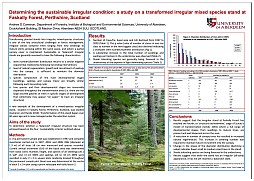
6. Determining the Sustainable Irregular Condition: a Study on a Transformed Irregular Mixed Species Stand at Faskally Forest, Perthshire, Scotland
Dr. Andrew D. Cameron
Department of Forestry
University of Aberdeen
Abstract:
AThe development of a mixed-species irregular stand in the latter stages of transformation was examined. Transformation of the stand, located in Faskally Forest, Scotland, began over 60 years ago and it is now managed under the selection system. The aim was to determine whether a sustainable irregular state has been reached based on a stable diameter distribution following harvesting interventions, sufficient regeneration and recruitment into the canopy of the desired species to maintain the distribution, relatively stable species composition in the main developmental stages (seedlings, saplings and canopy trees), and dispersal of these developmental stages throughout the transformation area. Complete inventories at 6-year intervals were carried out in a 1-ha permanent sample plot established in 1997. Results from the 2009 inventory suggest that the stand has not reached a sustainable irregular condition based on the above criteria. While the stand has a good dispersal of the main developmental stages, there has been a reduction in canopy tree number in the last harvesting intervention has slightly flattened the diameter distribution (q = 1.4 cf. 1.5 and 1.6 in 2003 and 1997 inventories, respectively). The reduction in overhead cover has increased the number of regenerating seedlings in the understorey and suggests that the stand is moving towards a more balanced structure. Not surprisingly, shade tolerating species are beginning to dominate the understorey. The next inventory takes place in 2015 when a better understanding of stand development will be possible, in particular the all-important level of recruitment into the canopy.
- View / downdload poster [PDF, 700 KB]
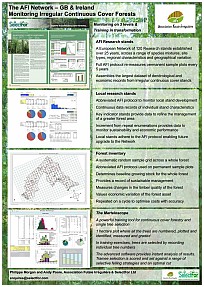
7. The AFI Network – GB & Ireland Monitoring Irregular Continuous Cover Forests
Phillippe Morgan and Andy Poore
Association Futaie Irrégulière & SelectFor Ltd
Abstract:
The Association Futaie Irrégulière (AFI) is a leading organization of private forest owners, based in France, who have adopted continuous cover forest management systems. The association has established a network of research stands throughout western and northern Europe to monitor the development of uneven-aged forests. The network currently numbers over 100 stands, and is expanding to new territories and countries including Canada and the US. Each stand is monitored according to a common protocol recording dendrological and economic factors. Stands are selected on the basis of structure, species mix, site type, geographical distribution and regional characteristics. To date, the network has contributed over 40,000 records to a continuous cover database that is centrally maintained and managed, and used for meta-analysis. The protocol for stand assessment has proved to be robust and efficient, and has provided evidence of cost-effective delivery of quality timber and enables forest owners to quantify a range of ecosystem services. In addition, AFI also provides support to members with local research stands and projects, and in technical support with forest inventory. The AFI is affiliated to Pro Silva, the close-to-nature forestry association.
- View / downdload poster [PDF, 2.0 MB]
- More information on the AFI network was given out during Phil Morgan’s presentation during the site visit to Thirlmere Forest. Link to PDF [PDF, 5.1 MB]
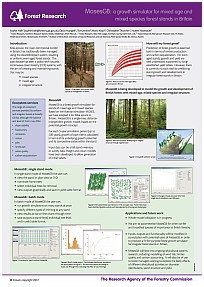
8. MosesGB: a Growth Simulator for Mixed Age and Mixed Species Forest Stands in Britain
Sophie Hale, Catia Arcangeli, Tom Jenkins, Mario Klopf,
Christopher Thurnher, Hubert Hasenauer,
Forest Research
Abstract:
Forests provide many ecosystem services e.g. timber, recreation, erosion control, biodiversity, jobs. The role of the traditionally-managed even-aged clearfell/restock spruce forests in Britain has predominantly been to provide timber, with associated jobs (many in rural areas).
A change of emphasis, to meet landscape and recreation as well, has resulted in corresponding changes in forest policy (UKWAS, country strategies, etc.). These have increased interest in alternative management approaches which can result in more forest stands of mixed age, species or structure. The existing growth and yield models for Britain, designed for even-aged forest management, are unsuited to predictions in these irregular stands.
MosesGB is a forest growth simulator for stands of mixed age and mixed species. Based on the Austrian simulator Moses, and initially adapted for Sitka spruce in Britain, MosesGB will be extended to incorporate other species. MosesGB is a single-tree, distance-independent growth model in which the growth of each individual tree in a stand is calculated in terms of its underlying growth potential (site and species specific) and its specific competitive status.
The simulator can be run either in batch mode or single stand mode. The single stand mode allows visualisation of the stand where the user can select individual trees for removal.
MosesGB will be of use as a research tool to underpin silvicultural systems research, wind risk modelling, timber quality modelling, carbon accounting, determination of forest characteristics from remote-sensing data, correlation between stand structure and abundance/availability of habitats. It also has the potential for use by forest managers wishing to explore the likely effects of different silvicultural activities on dbh distributions, stand structure, timber size etc.
- View / downdload poster [PDF, 2.6 MB]
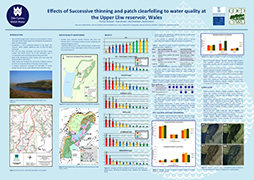
9. Effects of successive thinning and patch clear felling to water quality at the Upper Lliw reservoir, Wales
Thomaz Andrade, Ryan Bowen, Rick Shakesbury, David Jenkins
Abstract:
Many potable water reservoirs in Wales are surrounded by mature even-aged coniferous forests where clear felling has been identified as a major risk to water quality. The objective of this project was to evaluate the impact of different forest management strategies on water quality in an upland potable water catchment in South Wales. Water quality was monitored for 18 months within a 25-ha coniferous woodland which is in the process of changing from dense even-aged to continuous cover forestry. Areas of clearfelled, thinned and dense (unmanaged) areas were compared in terms of stream water quality, and through the leachability of metals in local soil profiles. The effects of ground disturbance were still present after 3 to 4 years of recovering, as areas of clearfelling and windblow generated significantly higher inputs of colour, organics, turbidity and metals to the water courses within the woodland, both in wet and dry conditions. Thinning with no or minimum windblow did not appear to cause deterioration in water quality and an improvement of water quality did occur in some thinning plots in comparison with unmanaged stands. Thinning reduced the leachability of aluminium and manganese in soils, while no clear effect was observed for iron.
- View / download poster [PDF, 6.17 MB]
